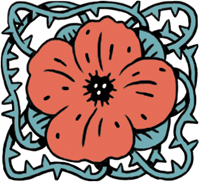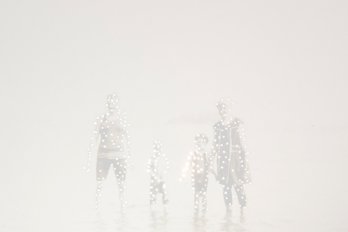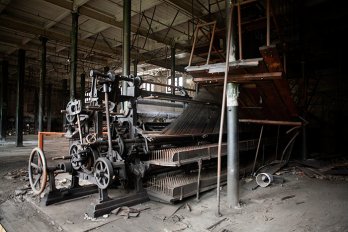There are no poppies at this time of year, just fields of sugar beets and hops. Every few hundred metres, there’s a sign for a cemetery, and a patch of white uniform gravestones, row on row, in Flanders fields. More than 50,000 Canadian soldiers lost their lives in World War I, Canada’s most legendary contribution to any war. The Flemish think so, anyway. Last post is still played every evening at the Menin Gate in Ypres, Belgium; down the road, when a middle-aged man at a gas station asks where I’m from and I say Canada, he drops his squeegee, pumps my hand, and says thank you.
Not far from Ypres, the Trappist monks at the abbey of Saint Sixtus were making limited quantities of their Westvleteren beer long before Canadian soldiers dug their first trenches. After the war, in 1931, the monks began selling three varieties—blond, dark, and darker—meting them out to lesser souls for a pittance.
Pushing Pin
Why poppy stickers are taking hold
Kelsey Heinrichs
Five years ago, the Royal Canadian Legion began issuing self-adhesive poppies to protect Remembrance Day observers, especially the youngest and the oldest, from becoming human pincushions. Sales rose from 1.35 million poppies in 2011 to 1.5 million pre-ordered by the summer of 2012 (and still counting). The new stickers have the added benefit of sidestepping pin-related protocol. According to the Legion’s Poppy Manual, exchanging the standard-issue straight pin for a more secure fastening defaces the “sacred symbol of remembrance,” and violates the registered trademark. This poses a challenge for those who wish to wear the poppy from “the last Friday in October to the end of day on November 11,” as anyone who has ever lost a pin well knows. The manual goes on to declare that it is still better to wear a poppy secured with a Canadian flag pin than none at all—or, presumably, a decal.
—Vanessa Pinto
Just as Ypres attracts History Channel buffs and pilgrims of all things World War I, Saint Sixtus draws enthusiasts from around the world. Westvleteren is one of the world’s seven rare genuine Trappist beers, meaning that all of the ingredients must be grown on the property of the abbey that makes it. Saint Sixtus is also the sole Trappist abbey where monks alone do the brewing. You can’t buy the beer in a bar or a store. You can find some for sale on eBay, but that’s strictly against the rules; the abbey only sells the brew directly to consumers, and asks them not to resell it to third parties. At last check, six bottles of Westvleteren 12—the darkest variety, widely considered the best beer in the world—went for anywhere from about $100 to $150 (US) on eBay. At Saint Sixtus, a crate of twenty-four would go for about $48 (US), since the monks cannot sell the beer for profit.
Neither I nor my brother-in-law Jeroen van Broekhuizen can lie to a monk, which is how we found ourselves on a 500-kilometre round trip from Rotterdam to Ypres, just to collect Jeroen’s two-case allotment. Only the truly dedicated get the beer: you have to pick it up in person, and you must call on designated days to arrange an appointment. Jeroen spent four mornings on the phone to the abbey, and when he finally got through he was instructed to come the following Saturday at 2:45 p.m. sharp. He could have forty-eight bottles of 8 percent dark (though he would have preferred the darker 10 percent), and if he couldn’t make it, tough. He also had to provide his licence plate and phone numbers, because he will have to wait sixty days before once again embarking on the elaborate procurement process.
Now, driving hundreds of kilometres every two months is not something most of us would do for a few cases of beer, or slightly less than one bottle a day between potential purchases. And yet when we arrive, cars from France, Holland, Belgium, Germany, and even the UK are lined up at the entrance. We’re a bit early, and the place is still closed, so we compare distances travelled with the other drivers and trade stories about past visits. All of us here are pilgrims of one kind or another.
When the gate opens, two Belgians on foot charge inside first to claim their prize. Picking up the beer is a remarkably unceremonious event: in and out, hand over the cash, next please. No lingering, and not even a glimpse of the abbey, which is famously closed to the public, with high walls to foil the curiosity of prying eyes.
Visits to the cemeteries and trenches around Ypres have been growing in recent years. So, too, have visits to places like Saint Sixtus—although the abbey is better known to war buffs as a place where Allied troops were once cared for. As we careen through Flanders’ winding single lanes on our way home, it’s impossible not to see bucolic pastures and forests for the muddy fields and trenches they once were, or to recall the strangeness of local conversations overheard: the barbed wire turned up while plowing, the body uncovered while digging a foundation for an addition to a house.
Another two and a half hours, forty euros in gas, and 250 kilometres later, we’re back in Rotterdam with a beer opener. And after washing the right glasses, and after waiting for ten minutes for the head to subside, and after finally taking one sip, I know that Westvleteren is easily—easily, easily—the best beer I’ve ever had. It’s smooth and earthy. You can taste each ingredient on its own, but none is overpowering. It’s lovely, and I would make the pilgrimage all over again. For the beer itself, sure, but also because the making and drinking of something beautiful softens the horror of almost a century ago, in a place where shrapnel and live munitions are still unearthed every day. It tames the ghosts whose tendrils still reach out. We live, feel dawn, see sunset glow—and now the hops grow—in Flanders fields.
This appeared in the November 2012 issue.





